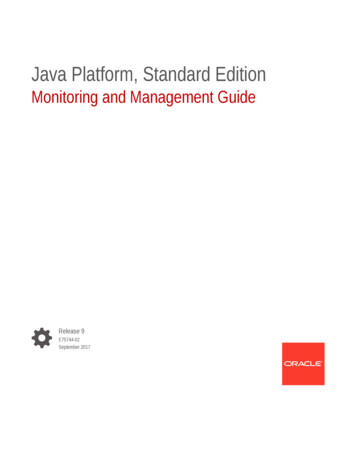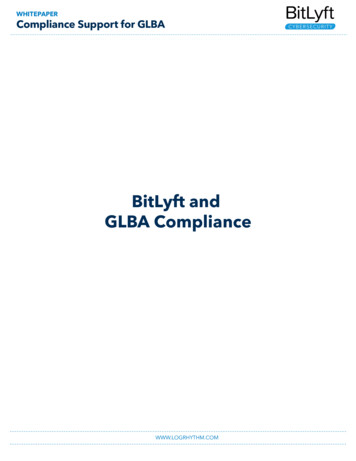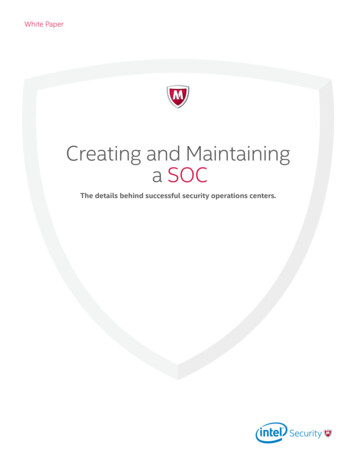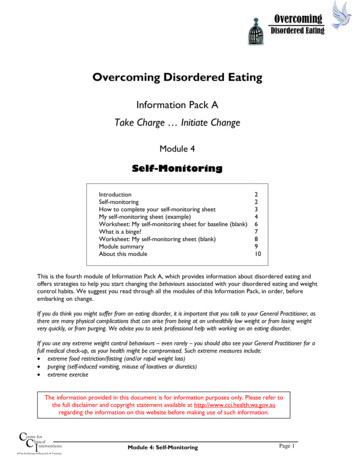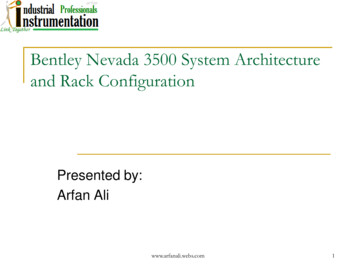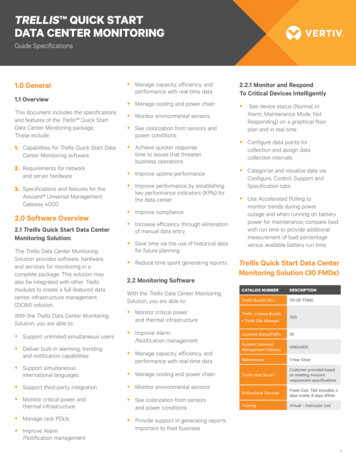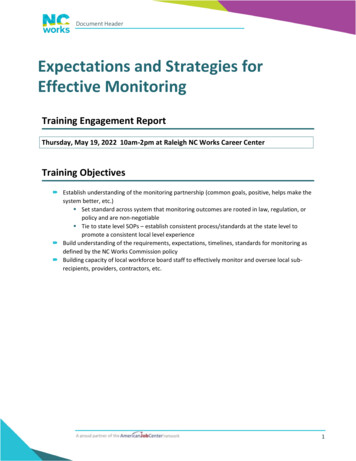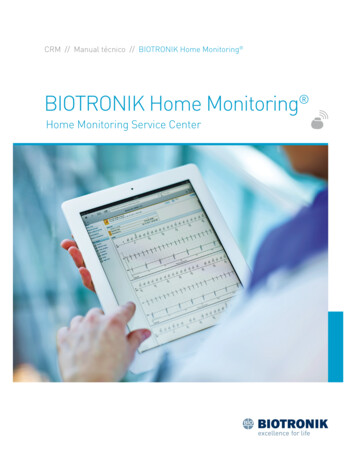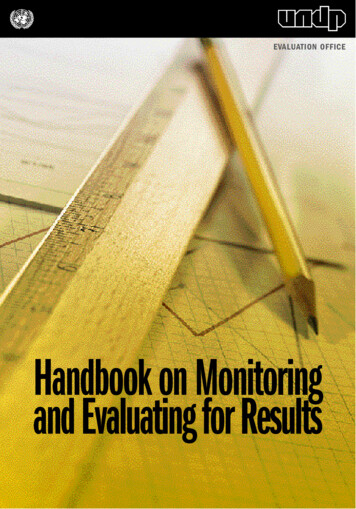
Transcription
E VA L UATION OFFICEHandbook on Monitoringand Evaluating for Results
Handbook on Monitoringand Evaluating for ResultsUNITED NATIONS DEVELOPMENT PROGRAMMEEVALUATION OFFICE
Evaluation Office 2002Evaluation OfficeUnited Nations Development ProgrammeOne United Nations PlazaNew York, NY 10017, USADesign: Colonial Communications Corp., New York, NY, USA
ForewordThe growing demand for development effectiveness is largely based on the realizationthat producing good “deliverables” is not enough. Efficient or well-managed projectsand outputs will lose their relevance if they yield no discernible improvement indevelopment conditions and ultimately in peoples’ lives. The United NationsDevelopment Programme is therefore increasing its focus on results and how it canbetter contribute to them.To support this strategic shift toward results, UNDP needs a strong and coherentmonitoring and evaluation framework that promotes learning and performancemeasurement. The framework must be simple and user-friendly enough for allstaff—project, programme and country office and headquarters—to use it in flexibleways that ultimately enhance the development effectiveness of the organizationas a whole. The monitoring and evaluation framework contained in this Handbookis therefore guided by three equally important objectives: to align the monitoringand evaluation system with results-based management; to promote evaluativeknowledge and learning around results; and to simplify policies and procedures.Changes in the mind-set and approach of staff are called for by several elements ofthis framework, which places a premium on coherent and long-range planning aroundresults; partnering for development change; capacity building for and ownershipof monitoring and evaluation; and promoting knowledge, learning and the use ofevaluative evidence. A certain amount of training will therefore be necessary.Although we fully expect to learn from the new framework and update it as it evolves,it is important to underscore that its introduction represents a key step forward forUNDP. The tools and policies described here are intended to promote the use ofevaluative evidence so that lessons learned inform our management decisions andfuture programming decisions. Furthermore, they are designed to help UNDPand its partners in development meet the challenge of choosing the right results,testing the accuracy of our development hypotheses and demonstrating how andwhy change happens where it matters most—in improving the lives of the poor.Zéphirin DiabréAssociate AdministratorJune 2002H A N D BOOK ON MONITORING AND EVA L UATING FOR RESULTSi
PrefaceSince 1999, UNDP has pursued a major programme of reform and renewal witha central objective: to demonstrate how and where the organization is making ameasurable contribution to the elimination of poverty. This effort depends onresults-based management (RBM), a methodology in which performance at thelevel of development goals and outcomes is systematically measured andimproved, and resources are strategically managed and put to the best possibleuse to enhance the organization’s development effectiveness.1 For UNDP, thisshift to a “culture of performance” calls for all programming instruments—includingmonitoring and evaluation—to be aligned with the RBM methodology.In the future, the success of UNDP will be measured by its contributions to theachievement of outcomes (the development changes that UNDP works towardsthrough, among other things, its projects, programmes and partnerships). It ismore evident than ever that development effectiveness rests on strengtheninginstitutions, improving policy frameworks and forging strategic partnerships.Monitoring and evaluation activities in UNDP are responding to the intensifiedfocus on outcomes by shifting towards better measurement of performance andmore systematic monitoring and reporting; most importantly, such activities arefostering an organizational culture of learning, transparency and accountability.This publication, The Handbook on Monitoring and Evaluating for Results, addressesthe monitoring and evaluation of development results. It is intended to supportcountry offices in aligning their monitoring and evaluation systems with RBMmethodology—specifically in tracking and measuring the performance of UNDPinterventions and strategies and their contributions to outcomes.2 It aims toprovide simple, flexible and forward-looking tools.12Throughout the publication,the terms “results-oriented”and “a results-based approach”are used in a general way to refer tothe methodology of “results-based management.”The Handbook specifically addresses the monitoring and evaluation of development results. It does not cover monitoring ofmanagement actions.Nevertheless, where monitoring and evaluation actions at country level also concern management action,this is mentioned.H A N D BOOK ON MONITORING AND EVA L UATING FOR RESULTSiii
While its primary audience is country office staff, the Handbook also will be of interestto others within UNDP who use information gained through monitoring and evaluationto report on results, improve interventions and make programme and policy decisions.It also will be of use to staff concerned with policy change and reform. Outside ofUNDP, it may be relevant to other United Nations agencies, governmental and nongovernmental organizations (NGOs), members of the academic community andindependent evaluators engaged by UNDP. The publication is expected to contributeto the capacity for results-oriented development within UNDP and its national partners.In addition to the printed version of this Handbook, the document is available in itsentirety on the Evaluation Office’s website (http://www.undp.org/eo/). The websitecontains frequently asked questions (FAQ), references to other resources and trainingpackages, and a periodic update and development of all monitoring and evaluationmethodologies within UNDP.This Handbook is the culmination of a comprehensive process of learning andconsultation, and has benefited from the input of a number of individuals, each whomdeserves special mention. First, thanks go to the Evaluation Office colleagues whohelped to conceive, draft and refine the Handbook over its many iterations. Specificthanks go to Siv Tokle, the Task Manager for the M&E guidelines revision, who ablymarshaled the process from its inception and helped draft the Handbook, and to LindaMaguire, who contributed to the drafting as well as helped to develop new outcomeevaluation methodologies.The Handbook also benefited from the inputs of a “Yellow Handbook Focal PointGroup”, comprising UNDP and UN agencies colleagues who provided substantiveand technical input and feedback to the various drafts. A validation workshop on thesemi-final draft of this Handbook was held in Istanbul, Turkey in October 2001, wherea number of UNDP country office colleagues offered their valuable perspectives andhelped further refine the policies and processes in the Handbook to make them more“country office friendly”. This Handbook also owes a great deal of substantivegrounding to the simplification task force of UNDP and to the “champions” of thiseffort to make UNDP’s policies and procedures more straightfoward, results basedand oriented to learning.Last, but certainly not least, I should acknowledge the invaluable assistance of theEvaluation Office’s technology manager, Anish Pradhan; the editing skill of SusanGuthridge-Gould; and the excellant design and format of the Handbook by Julia Ptasznik.Khalid MalikDirectorEvaluation OfficeivH A N D BOOK ON MONITORING AND EVA L UATING FOR RESULTS
ContentsIntroduction1PART I. THE MONITORING AND EVALUATION FRAMEWORK3Chapter 1. Purposes and DefinitionsChapter 2. The Shift Towards Results-Based Management59PART II. HOW TO CONDUCT MONITORING AND EVALUAT I O N21Chapter 3. Planning for Monitoring and EvaluationChapter 4. The Monitoring Process (“how to ”)Chapter 5. The Evaluation Process (“how to ”)233145PART III. M O N I TORING AND EVALUATING PERFORMANCE61Chapter 6. Performance Measurement63PART IV. USE OF MONITORING AND EVALUATION INFORMAT I O N73Chapter 7. Knowledge and Learning: Use of Evaluative Evidence75Conclusion89RESOURCES AND A N N E X E S91AcronymsGlossaryRelated Documents and WebsitesMonitoring and Evaluation ToolsAnnex A: Evaluation and Tracking PlanAnnex B: Evaluation Terms of Reference (TOR)Annex C: Annual Project Report (APR)Annex D: Field Visit ReportAnnex E: Menu of Monitoring ToolsH A N D BOOK ON MONITORING AND EVA L UATING FOR RESULTS9397109127128131134136138v
IntroductionPurpose of the HandbookThe Handbook on Monitoring and Evaluating for Results is intended to: Strengthen the results-oriented monitoring and evaluation function andcapacity in UNDP for the purpose of improving programmes and policies,organizational learning and accountability; Introduce simplified, streamlined and flexible approaches and tools tomonitor progress towards outcomes that are consistent with the organization’ssimplification initiative and that draw on the experience of UNDP and itspartners; Present methods to link the outputs of UNDP projects, programmes,policies, partnerships and “soft” assistance with progress towards outcomes within the Strategic Results Framework (SRF);3 Explain new innovations and methodologies in results-oriented monitoringand evaluation, including the role of partners; Provide practical guidance to country offices on monitoring and performance assessment.Structure and contentThe Handbook is organized as follows:Part I presents the conceptual and operational framework for monitoring andevaluation in a results-based context. It introduces the elements of the newframework, defines the key concepts of outcome monitoring and outcome evaluation,and delineates their scope and purposes.3See the Glossary for a complete definition of the SRF.H A N D BOOK ON MONITORING AND EVA L UATING FOR RESULTS1
Part II is the main body of the Handbook, intended for daily use. It provides practicalguidance on the planning, organization and conduct of monitoring and evaluationprocesses focused on development results (outcomes and outputs). It providesapproaches and methods that can be used to measure performance through monitoringand evaluation. The corresponding tools are featured in annexes.Part III discusses performance measurement and the use of indicators in monitoringand evaluation.Part IV addresses the role of evaluative evidence for organizational learning andknowledge management.The Annex includes samples and optional, flexible formats for selected monitoring andevaluation tools, such as sample Terms of Reference (TOR) and an annotated outlinefor an outcome-level evaluation report, which will be available electronically for easyadaptation. Also in the annex are the glossary, a list of acronyms and a bibliography.Consult the UNDP Evaluation Office (EO) website (http://www.undp.org/eo/) forthe following: Samples and formats for selected monitoring and evaluation tools; Bibliographic and electronic references; Information resources of UNDP and partner agencies; Updates, lessons learned and additional experience related to the Handbook.Additional resources include publications in the Companion Series, which providemore in-depth guidance for monitoring and evaluation in select areas and forspecific target groups. Titles include Guidelines for Outcome Evaluators and EvaluationCapacity Development.All users of this Handbook are encouraged to provide feedback on the publication aswell as lessons learned from experience to the Evaluation Office, thereby helping toimprove continually the monitoring and evaluation framework. Please consult the EOwebsite for the most up-to-date developments in the application of monitoring andevaluation for results.2H A N D BOOK ON MONITORING AND EVA L UATING FOR RESULTS
PARTIThe Monitoring andEvaluation Framework
Chapter 1. Purposes and DefinitionsA. Purposes of monitoring and evaluationB. Definitions of monitoring and evaluationChapter 2. The Shift Towards Results-Based ManagementA. Monitoring and evaluation in the context of RBMB. Implications for the country office5569916Figures, Tables and Boxes for Part IFigure 1. Objectives of monitoring and evaluationFigure 2. The results chainFigure 3. How is “soft” assistance provided?Figure 4. Monitoring and evaluation responsibilities of Programme Managers671519Table 1. Key features of implementation versus outcome monitoringTable 2. Differences between outcome monitoring and outcome evaluationTable 3. Changes to tools used for programming, monitoring and evaluationTable 4. Country-level roles and responsibilities for monitoring and evaluation11121718Box 1. The roles of partners in monitoring and evaluationBox 2. As a Programme Manager, what do I need to do differently?1419
Purposesand DefinitionsCHAPTER 1Monitoring and evaluation enhance the effectiveness of UNDP assistance by establishingclear links between past, present and future interventions and results. Monitoring andevaluation can help an organization to extract, from past and ongoing activities, relevantinformation that can subsequently be used as the basis for programmatic fine-tuning,reorientation and planning. Without monitoring and evaluation, it would be impossible tojudge if work was going in the right direction, whether progress and success could beclaimed, and how future efforts might be improved.This chapter highlights the main purposes of monitoring and evaluation,and explains howthese functions are of use to the organization. This chapter also provides definitions ofmonitoring and evaluation.This chapter covers:A. Purposes of monitoring and evaluationB. Definitions of monitoring and evaluationA. Purposes of Monitoring and EvaluationMonitoring and evaluation help improve performance and achieve results. Moreprecisely, the overall purpose of monitoring and evaluation is the measurementand assessment of performance in order to more effectively manage theoutcomes and outputs known as development results. Performance is defined asprogress towards and achievement of results. As part of the emphasis on resultsin UNDP today, the need to demonstrate performance is placing new demandson monitoring and evaluation in country offices (COs) and programme units.Traditionally, monitoring and evaluation focused on assessing inputs and implementation processes. Today, the focus is on assessing the contributions of various factorsto a given development outcome, with such factors including outputs, partnerships,policy advice and dialogue, advocacy and brokering/coordination. ProgrammeH A N D BOOK ON MONITORING AND EVA L UATING FOR RESULTS5
Managers are being asked to actively apply the information gained through monitoringand evaluation to improve strategies, programmes and other activities.The main objectives of today’s results-oriented monitoring and evaluation are to: Enhance organizational and development learning; Ensure informed decision-making; Support substantive accountability and UNDP repositioning; Build country capacity in each of these areas, and in monitoring and evaluating functions in general.FIGURE 1. OBJECTIVES OFMONITORING AND EVALUATIONMonitoring and evaluation help staff to.Be accountable &repositionourselvesThese objectives are linked together in acontinuous process, as shown in Figure 1.Learning from the past contributes tomore informed decision-making. Betterdecisions lead to greater accountabilityto stakeholders. Better decisions alsoimprove performance, allowing for UNDPactivities to be repositioned continually.Partnering closely with key stakeholdersthroughout this process also promotesLearnshared knowledge creation and learning,fromMakehelps transfer skills, and develops theexperiencemorecapacity of UNDP country offices andinformedprojectsfor planning, monitoring anddecisionsevaluation. These stakeholders alsoprovide valuable feedback that canbe used to improve performance andlearning. In this way, good practices atthe heart of monitoring and evaluation are continually reinforced, making a positivecontribution to the overall effectiveness of development.BuildCapacitiesB. Definitions of Monitoring and EvaluationMonitoring can be defined as a continuing function that aims primarily to provide themanagement and main stakeholders of an ongoing intervention with early indicationsof progress, or lack thereof, in the achievement of results. An ongoing interventionmight be a project, programme or other kind of support to an outcome. (See Chapter 4and the Annexes for more on monitoring.)Evaluation is a selective exercise that attempts to systematically and objectively assessprogress towards and the achievement of an outcome. Evaluation is not a one-timeevent, but an exercise involving assessments of differing scope and depth carried out atseveral points in time in response to evolving needs for evaluative knowledge and learningduring the effort to achieve an outcome. All evaluations—even project evaluationsthat assess relevance, performance and other criteria—need to be linked to outcomes asopposed to only implementation or immediate outputs. (See Chapter 5 on evaluation.)6H A N D BOOK ON MONITORING AND EVA L UATING FOR RESULTS
Reporting is an integral part of monitoring and evaluation. Reporting is the systematicand timely provision of essential information at periodic intervals.Monitoring and evaluation take place at two distinct but closely connected levels:One level focuses on the outputs, which are the specific products and servicesthat emerge from processing inputs through programme, project and other activitiessuch as through ad hoc soft assistance delivered outside of projects and programmes.The other level focuses on the outcomes of UNDP development efforts, which arethe changes in development conditions that UNDP aims to achieve through itsprojects and programmes. Outcomes incorporate the production of outputs and thecontributions of partners.Traditionally, UNDP staff has been more familiar with the first level: monitoring andevaluation that is programme and project based and that views performance in termsof outputs. Today, the challenge is to go beyond this level and to link performancewith outcomes, with rigorous and credible assessments of progress towards andachievement of outcomes.Approaches, techniques and tools for monitoring and evaluation, which should beapplied at both levels, are presented throughout the Handbook. Figure 2 illustrateshow outputs and outcomes inter-relate during the process of achieving results.FIGURE 2.THE RESULTS CHAININPUTS Experts Equipment FundsOUTPUTS Studiescompleted People trainedOUTCOMESIncomeincreased Jobs created IMPACTHealth conditionsimproved Longevity increased Two other terms frequently used in monitoring and evaluation are defined below:Feedback is a process within the framework of monitoring and evaluation by whichinformation and knowledge are disseminated and used to assess overall progresstowards results or confirm the achievement of results. Feedback may consist offindings, conclusions, recommendations and lessons from experience. It can be usedto improve performance and as a basis for decision-making and the promotion oflearning in an organization. (See Chapter 7 on knowledge and learning.)A lesson learned is an instructive example based on experience that is applicable to ageneral situation rather than to a specific circumstance. It is learning from experience.The lessons learned from an activity through evaluation are considered evaluativeknowledge, which stakeholders are more likely to internalize if they have beeninvolved in the evaluation process. Lessons learned can reveal “good practices” thatsuggest how and why different strategies work in different situations—valuableinformation that needs to be documented.PURPOSES AND DEFINITIONS7
The Shift TowardsResults-BasedManagementCHAPTER 2This chapter defines results-based management (RBM) and highlights the main featuresof a results-based monitoring and evaluation system. It presents the role of monitoringand evaluation within the context of UNDP’s shift towards RBM, which has been gainingmomentum since 1999. It also compares past approaches with the current results-basedapproach. This chapter should help users pinpoint any areas in which changes in behaviorare required, and to align monitoring and evaluation activities accordingly.This chapter covers:A. Monitoring and evaluation in the context of RBM Outcome monitoring Outcome evaluation Relationship between outcome monitoring and outcome evaluation Importance of partnerships Significance of “soft” assistanceB. Implications for the country office Changes in tools and processes Roles and responsibilities Practical challenges for Programme ManagersA. Monitoring and Evaluation in the Context of RBMAn increasing emphasis on results is bringing about some major changes in thefocus, approach and application of monitoring and evaluation within UNDP.Central to these changes is results-based management.Results-based management (RBM) is a management strategy or approach bywhich an organization ensures that its processes, products and services contributeto the achievement of clearly stated results. Results-based management provides acoherent framework for strategic planning and management by improving learningH A N D BOOK ON MONITORING AND EVA L UATING FOR RESULTS9
and accountability. It is also a broad management strategy aimed at achieving importantchanges in the way agencies operate, with improving performance and achievingresults as the central orientation, by defining realistic expected results, monitoringprogress toward the achievement of expected results, integrating lessons learned intomanagement decisions and reporting on performance.OUTCOME MONITO R I N GUNDP interventions consist of projects, programmes, partnerships and “soft” assistancesuch as advocacy delivered outside projects or programmes—all acting in concert toachieve an outcome, or development change. The monitoring of these outcomesrepresents a distinct shift away from the past interest in monitoring project outputs.As noted in Chapter 1, this shift will make it possible to determine the success ofUNDP interventions by their measurable contribution to development changes.Outcome monitoring is a continual and systematic process of collecting and analyzingdata to measure the performance of UNDP interventions towards achievement ofoutcomes at country level. While the process of outcome monitoring is continual inthe sense that it is not a time-bound activity, outcome monitoring must be periodic,so that change can be perceived. In other words, country offices will accumulateinformation on an ongoing basis regarding progress towards an outcome, and then willperiodically compare the current situation against the baseline for outcome indicatorsand assess and analyze the situation.In order for a country office to monitor outcomes and outputs effectively, that countryoffice has to determine exactly which projects, programmes and other activities contributeto any specific outcome. “Other activities” may include advice, advocacy and othertypes of soft assistance delivered outside of projects or programmes.Outcome monitoring focuses on the following interventions and strategies and theirimplications: Projects; Programmes; Partnerships; “Soft” assistance in the form of policy advice, policy dialogue, advocacy, brokerage/coordination provided outside of established projects or programmes; Implementation strategies.How do Programme Managers carry out outcome monitoring? They track the outputsand measure their contributions to outcomes by assessing the change from baselineconditions. Programme Managers need to keep an eye on key outputs (the specificproducts and services that emerge from processing inputs through project/programmeor non-project/programme activities) because they can indicate whether a strategy isrelevant and efficient or not. Relevance in a results-based context refers to whetheror not a UNDP intervention contributes to the achievement of a key outcome, supportsnational development priorities and targets appropriate groups.To conduct effective outcome monitoring, Programme Managers need to establishbaseline data, select outcome indicators of performance, and design mechanisms thatinclude planned actions such as field visits, stakeholder meetings and systematicanalysis or reports.10H A N D BOOK ON MONITORING AND EVA L UATING FOR RESULTS
TABLE 1. KEY FEATURES OF IMPLEMENTATION VERSUS OUTCOME MONITORINGELEMENTS OF IMPLEMENTATION MONITORING(traditionally used for projects) Description of the problem or situationbefore the inter vention;Benchmarks for activities andimmediate outputs;Data collection on inputs, activities andimmediate outputs;Systematic reporting on provision ofinputs, etc.;Directly linked to a discrete intervention(or series of inter ventions);Designed to provide information onadministrative, implementation andmanagement issues as opposed to broaderdevelopment effectiveness issues.ELEMENTS OF OUTCOME MONITORING(used for a range of interventions and strategies) Baseline data to describe the problem orsituation before the inter vention;Indicators for outcomes;Data collection on outputs and how/whether theycontribute towards achievement of outcomes;More focus on perceptions of change amongstakeholders and more focus on “soft” assistance;Systematic reporting with more qualitativeand quantitative information on the progressof outcomes;Done in conjunction with strategic partners;Captures information on success or failureof UNDP partnership strategy in achievingdesired outcomes.It is important to remember that outcome monitoring is not the same as implementationmonitoring, as shown in Table 1. Project Managers in particular will still be expectedto monitor the implementation of their projects. This monitoring should be plannedand integrated with any outcome monitoring to avoid duplication and to lowertransaction costs.OUTCOME EVALUAT I O NAn outcome evaluation is an evaluation that covers a set of related projects,programmes and strategies intended to bring about a certain outcome. Such evaluations assess how and why outcomes are or are not being achieved in a given countrycontext, and the role UNDP has played. They may also help to clarify underlyingfactors affecting the situation, highlight unintended consequences (positive andnegative), recommend actions to improve performance in future programming, andgenerate lessons learned. These periodic and in-depth assessments use “before andafter” monitoring data.Outcome evaluations may fulfill different needs at different times throughout theprogramming cycle. If conducted early in the cycle, they can supply informationabout potential impediments; if conducted halfway through the cycle, they cansuggest mid-course adjustments; and if conducted at the end, they can contribute tolessons learned that could guide work in the outcome during the next cycle.An outcome evaluation extracts lessons learned, findings and recommendations byassessing the following: Progress towards the outcome; Factors contributing to the outcome (substantive influences); Key UNDP contributions (outputs, including those produced through “soft”assistance) to outcomes; The partnership strategy (how UNDP works with its partners).THE SHIFT TOWARD RESULTS-BASED MANAG E M E N T11
Assessments of these four major components are carried out in varying degrees ofdepth, depending upon the specific purpose of the evaluation. Additional areas forassessment may be added, although this requires additional time and financialresources and may yield less detailed results.How do Programme Managers carry out outcome evaluations? Working with thecountry office team, Programme Managers plan outcome evaluations at the countrylevel using the Evaluation Plan. (See Chapter 3.) Country offices need to set asideadequate resources for these activities. Planning significantly improves the managementand quality of evaluation. Country offices (and headquarters units) are responsible, inpartnership with strategic partners, for planning all aspects of outcome evaluations,from defining the objectives to collecting the data. Programme Managers, by liaisingwith the appropriate levels of management from project to country office, are responsiblefor ensuring that baseline data and appropriate indicators of performance are establishedat the very start of an intervention.R E L ATIONSHIP BETWEEN OUTCOME MONITORING AND OUTCOME EVALUAT I O NBoth outcome monitoring and outcome evaluation are aimed at the systematic collectionand analysis of information to track changes from baseline conditions to the desiredoutcome and to understand why change is or is not taking place. Both functions areclosely linked to decision-making processes at programme and policy levels. Bothprovide consistent information for the improvement of interventions and strategies toProgramme Managers, Project Managers and stakeholders. And both can demonstrateaccountability. They differ, however, in their specific objectives, focus and methodology,and how they are conducted and used, as summarized in Table 2.4TABLE 2. DIFFERENCES BETWEEN OUTCOME MONITORING AND OUTCOME EVALUATION412OUTCOME MONITORINGOUTCOME EVALUATIONObjectiveTo track changes from baselineconditions to desired outcomes.To validate what results were achieved,and howand why they were or were not achieved.FocusFocuses on the outputs of projects,programmes,partnerships andsoft assistance activities and theircontribution to outcomes.Compares planned with intended outcomeachievement. Focuses on how and why outputsand strategies contributed to achievement ofoutcomes. Focuses on questions of relevance,effectiveness, sustainability and change.MethodologyTracks and assesses performance(
fostering an organizational culture of learning, transparency and accountability. This publication, The Handbook on Monitoring and Evaluating for Results, a d d r e s s e s the monitoring and evaluation of development results. It is intended to support country offices in aligning their monitoring and evaluation systems with RBM

